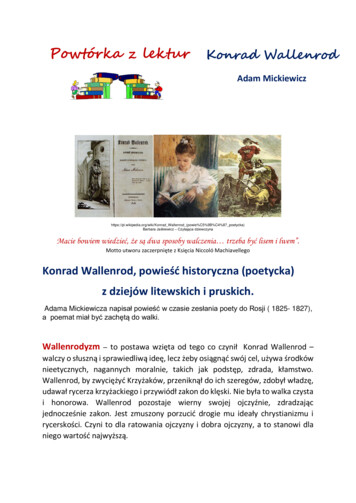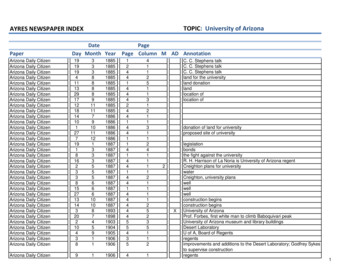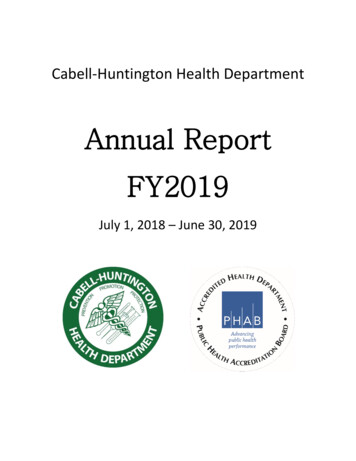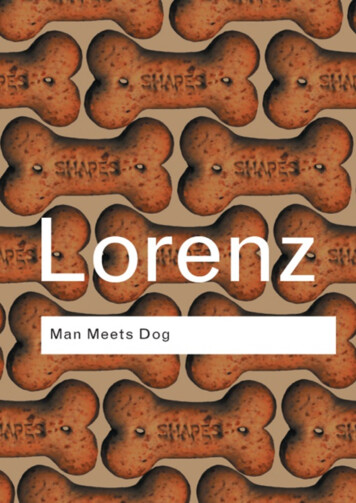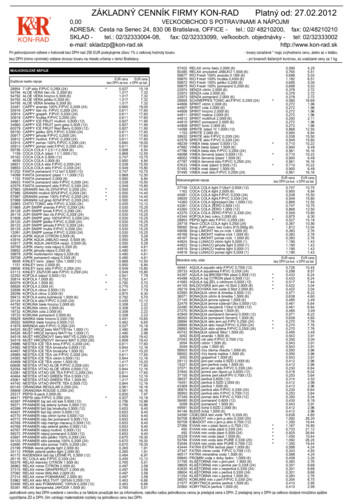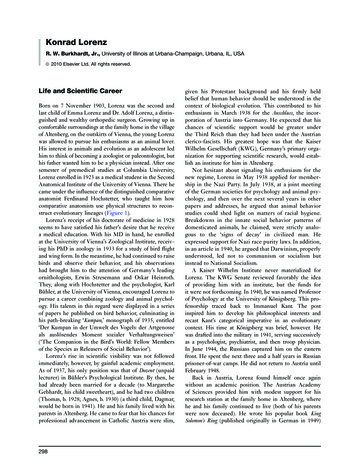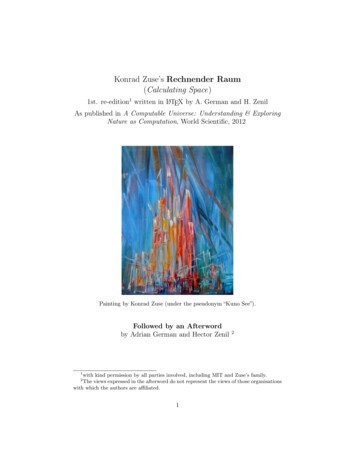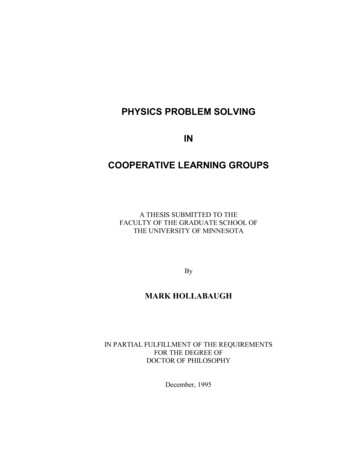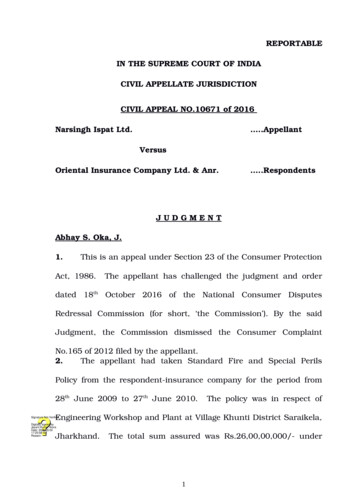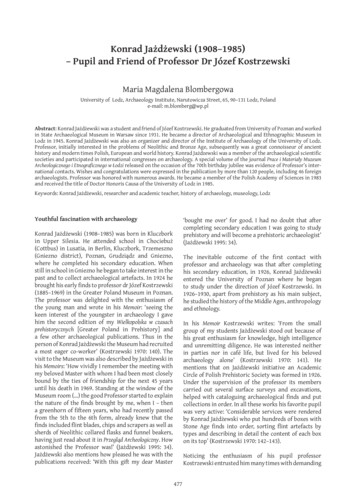
Transcription
Konrad Jażdżewski (1908–1985)– Pupil and Friend of Professor Dr Józef KostrzewskiMaria Magdalena BlombergowaUniversity of Lodz, Archaeology Institute, Narutowicza Street, 65, 90–131 Lodz, Polande-mail: m.blomberg@wp.plAbstract: Konrad Jażdżewski was a student and friend of Józef Kostrzewski. He graduated from University of Poznan and workedin State Archaeological Museum in Warsaw since 1931. He became a director of Archaeological and Ethnographic Museum inLodz in 1945. Konrad Jażdżewski was also an organizer and director of the Institute of Archaeology of the University of Lodz.Professor, initially interested in the problems of Neolithic and Bronze Age, subsequently was a great connoisseur of ancienthistory and modern times Polish, European and world history. Konrad Jażdzewski was a member of the archaeological scientificsocieties and participated in international congresses on archaeology. A special volume of the journal Prace i Materiały MuzeumArcheologicznego i Etnograficznego w Łodzi released on the occasion of the 70th birthday jubilee was evidence of Professor’s international contacts. Wishes and congratulations were expressed in the publication by more than 120 people, including 46 foreignarchaeologists. Professor was honored with numerous awards. He became a member of the Polish Academy of Sciences in 1983and received the title of Doctor Honoris Causa of the University of Lodz in 1985.Keywords: Konrad Jażdżewski, researcher and academic teacher, history of archaeology, museology, LodzYouthful fascination with archaeology‘bought me over’ for good. I had no doubt that aftercompleting secondary education I was going to studyprehistory and will become a prehistoric archaeologist’(Jażdżewski 1995: 34).Konrad Jażdżewski (1908–1985) was born in Kluczborkin Upper Silesia. He attended school in Chociebuż(Cottbus) in Lusatia, in Berlin, Kluczbork, Trzemeszno(Gniezno district), Poznan, Grudziądz and Gniezno,where he completed his secondary education. Whenstill in school in Gniezno he began to take interest in thepast and to collect archaeological artefacts. In 1924 hebrought his early finds to professor dr Józef Kostrzewski(1885–1969) in the Greater Poland Museum in Poznan.The professor was delighted with the enthusiasm ofthe young man and wrote in his Memoir: ‘seeing thekeen interest of the youngster in archaeology I gavehim the second edition of my Wielkopolska w czasachprehistorycznych [Greater Poland in Prehistory] anda few other archaeological publications. Thus in theperson of Konrad Jażdżewski the Museum had recruiteda most eager co-worker’ (Kostrzewski 1970: 140). Thevisit to the Museum was also described by Jażdżewski inhis Memoirs: ‘How vividly I remember the meeting withmy beloved Master with whom I had been most closelybound by the ties of friendship for the next 45 yearsuntil his death in 1969. Standing at the window of theMuseum room ( ) the good Professor started to explainthe nature of the finds brought by me, when I – thena greenhorn of fifteen years, who had recently passedfrom the 5th to the 6th form, already knew that thefinds included flint blades, chips and scrapers as well assherds of Neolithic collared flasks and funnel beakers,having just read about it in Przegląd Archeologiczny. Howastonished the Professor was!’ (Jażdżewski 1995: 34).Jażdżewski also mentions how pleased he was with thepublications received: ‘With this gift my dear MasterThe inevitable outcome of the first contact withprofessor and archaeology was that after completinghis secondary education, in 1926, Konrad Jażdżewskientered the University of Poznan where he beganto study under the direction of Józef Kostrzewski. In1926–1930, apart from prehistory as his main subject,he studied the history of the Middle Ages, anthropologyand ethnology.In his Memoir Kostrzewski writes: ‘From the smallgroup of my students Jażdżewski stood out because ofhis great enthusiasm for knowledge, high intelligenceand unremitting diligence. He was interested neitherin parties nor in café life, but lived for his belovedarchaeology alone’ (Kostrzewski 1970: 141). Hementions that on Jażdżewski initiative an AcademicCircle of Polish Prehistoric Society was formed in 1926.Under the supervision of the professor its memberscarried out several surface surveys and excavations,helped with cataloguing archaeological finds and putcollections in order. In all these works his favorite pupilwas very active: ‘Considerable services were renderedby Konrad Jażdżewski who put hundreds of boxes withStone Age finds into order, sorting flint artefacts bytypes and describing in detail the content of each boxon its top’ (Kostrzewski 1970: 142–143).Noticing the enthusiasm of his pupil professorKostrzewski entrusted him many times with demanding477
Between History and Archaeologytasks both in Museum and during fieldwork. Owingto this, Jażdżewski acquired practice in excavationmethods and in dealing with archaeological finds.Kostrzewski also noticed in his Memoir that Jażdżewskiwhen still an undergraduate wrote his first article(Jażdżewski 1927), ‘which was not a mere report on hisown excavations, but included the first list of the so farknown sites of the Pit-Comb Ware culture in GreaterPoland’ (Kostrzewski 1970: 143).Jażdżewski took his MA degree on the basis of histhesis Dwa cmentarzyska łużyckie na Górnym Śląsku [TwoLusatian cemeteries in Upper Silesia] (Jażdżewski1932a) and in 1935 he presented his PhD thesis Kulturapucharów lejowatych w Polsce Zachodniej i Środkowej [TheFunnel Beaker culture in West and Central Poland](Jażdżewski 1936). Both his dissertations were highlyrated and Jażdżewski was twice awarded silver medalsby Poznan University. In early 1939 he gained a postdoctoral degree and title of a Reader. Later in the sameyear he was appointed Professor of Prehistory at StefanBatory University in Vilnius. The outbreak of the warthwarted these plans.This stage of scholarly activity of Konrad Jażdżewskiwas summed up by Józef Kostrzewski as follows:‘Already before World War II K[onrad] Jażdżewski roseto a leading position in the generation of young Polishprehistorians’ (Kostrzewski 1970: 144; Fig. 1).Fig. 1. Konrad Jażdżewski (1908–1985). 1936. Fromthe collection of the the Museum of Archaeology andEthnography in Lodz.The first period of scholarly activityAs mentioned above, Konrad Jażdżewski wrote his firstarticle in 1926 and published it a year later. This paperwas the result of his own excavations and of his workin the Prehistoric Department of the Museum wherebetween 1926–1939 he was employed as an unpaidtrainee. Besides, in 1928–1930 he was a deputy assistantat the Chair of Prehistory at Poznan University. At thattime he was primarily interested in the Neolithic andEarly Bronze Age of Europe, notably Poland. He plannedto prepare a monograph of particular Neolithic andEarly Bronze Age cultures in Poland and neighbouringcountries. However, he managed to fulfill his plan onlyin relation to the Funnel Beaker culture (Jażdżewski1995: 110), which became the subject of his PhD thesis,published in 1936.its origin, its development, its relation with othercultures and its final phases. The travel was profitablein more than one respect as the young scholar in thecourse of visiting various archaeological institutionshad the opportunity to meet their directors andstaff, e.g. a scholar of great renown Sophus Müller(1846–1934) in Copenhagen and Wilhelm Unverzagt(1892–1971), director of Staatliches Museum für Vorund Frühgeschichte in Berlin (Jażdżewski 1995: 77–91).These contacts have been sustained for many years.The results of the studies performed during that travelwere published in Praehistorische Zeitschrift (Jażdżewski1932b, see 1995: 69–90).To enrich his knowledge of Neolithic cultures hetravelled from early October 1930 to the end ofFebruary 1931 to various German and Danish museums.For that purpose the National Culture Fund grantedhim an award. His objective was to collect materialswhich would illustrate ties of the Funnel Beaker culturein Poland with finds of this culture in eastern andnorthern Germany and Denmark, and to try to explainAfter leaving the University Konrad Jażdżewski wasemployed with the State Archaeological Museumin Warsaw as an assistant. The change in its life hedescribed thus in his Memoirs: ‘In early 1931 I begana new chapter in my life being employed by the StateArchaeological Museum in Warsaw of nation-widescope. At that time its archaeological collections werehoused in the building of the former Cadet School in478
Maria Magdalena Blombergowa: Konrad Jażdżewski (1908–1985)close neighbourhood of the royal Łazienki Palace andnear a pretty pond. This building, from which the cadetsset off to start the November uprising of 1830, was nota place, where a museum which should satisfy the needsof prehistoric archaeology nation-wide, could functionproperly. It contained several rooms and 2 widecorridors on the ground floor, housing museum offices,living quarters of a janitor, a library, the director’sstudy and a conservation room. The conditions werevery cramped .’ (Jażdżewski 1995: 91–93). The Museumdirector, dr Roman Jakimowicz (1889–1951), like JózefKostrzewski, was very friendly towards the youngarchaeologist. Jażdżewski settled in Warsaw, where in1936 he married Stefania Jasnorzewska (1911–1998),a graduate of the Jagiellonian University where she hadstudied German and English philology.in the Kujawskie przyczynki do zagadnienia tubylczościSłowian na ziemiach polskich [Kuyavian’s contributionsto the problem of Slavic origin in Polish lands] readyto be published in vol. XVI of Wiadomości Archeologiczne(Jażdżewski 1939/48).Because of his research experience, his scholarlyachievements and many important publications tohis name, he was appointed professor of prehistory atStefan Batory University in Vilnius. Yet on 1 September1939 the situation in Vilnius, in whole Poland and thefate of Konrad Jażdżewski himself drastically changed –World War II broke out.Activity during World War II: 1939–1945The first months of war and German occupation ofPoland were marked by the demolition of cultural andacademic institutions. The same fate was encounteredby the State Archaeological Museum in Warsaw. On9 November 1939, during the absence of dr Jakimowicz,three German archaeologists arrived at the Museum:dr Ernst Petersen (1905–1944), professor of RostockUniversity, in the uniform of an SS–officer, dr HansSchleif (1902–1945) of Berlin University and GüntherThaeringen, all members of the SS–Ahnenerbeorganization. Threatening Konrad Jażdżewski witha gun, they demanded from him to hand over thosearchaeological objects which were unique on account oftheir scientific and material value (Lech and Piotrowska2007: 134). Moreover, they destroyed a large part ofWiadomości Archeologiczne ready for publication. Afterthis act of vandalism, they sealed the Museum andforbade entry. In January 1940 the German authoritiesappointed Jażdżewski keeper of the Museum. He wasto work there alone with only a janitor to help him.He learned later that the director, dr Jakimowicz wasdismissed and forbidden to enter the Museum premises,and on the demand of German authorities pointed toJażdżewski as his deputy. Jażdżewski began his job byputting things in order after the plundering of thecollections and damage done to the Museum building.Thanks to his excellent command of German andgood knowledge of the mentality of German officialshe managed in the course of time to increase thestaff to 20, including a few archaeologists, a zoologist,anthropologists and physical labourers. In this way heprotected them from persecution and forced labour inGermany, offered them the possibility to earn a livingand obtain ration-cards. In the autumn of 1940 theMuseum was transferred to the building of the NationalMuseum at 3 Maj Avenue.In 1933, having received information aboutarchaeological finds in Brześć Kujawski, Włocławekdistrict, Jażdżewski embarked on explorations inKujawy. He had been surveying this region till 1938.In the course of these studies, dropped only by theoutbreak of World War II, he had revealed traces ofseveral archaeological cultures, ranging from theend of the Paleolithic through the Mesolithic untilthe Middle Ages (11th–12th century): the Neolithicfinds, particularly those of the Linear Pottery andthe Lengyel-Polgar cultures, being by far the mostabundant (Jażdżewski 1933, 1936, 1937). In the areain question Jażdżewski had revealed and studied vastnumbers of settlement traces. Of exceptional interestwas the large fragment of a settlement site discoveredat Brześć Kujawski, Włocławek district, with wellpreserved remains of numerous long houses andgraves. These discoveries have thrown light on thecharacter of the first Neolithic settlement in Kujawyand on the settlement of characteristic assemblagesof the Lowland Neolithic which has been recognizedby several scholars as a separate unit called the BrześćKujawski group.Thanks to Konrad Jażdżewski and his co-workerStanisław Madajski (1908–1998) the post constructionsof that type have been for the first time recognizedas houses (Niesiołowska-Średniowska 2007: 74). Otherfeatures investigated by Jażdżewski in this regionare represented by the so-called Kuyavian graves –megalithic long mounds triangular in plan, built ofstone and earth, over 10 m high and occasionallymore than 100 m long. These graves, assigned to theFunnel Beaker culture, occur at Gaj, Koło district,Wietrzychowice and Sarnowo, Włocławek district. Theyears of investigations in Kujawy and its neighbourhoodhave been exactly described by Jażdżewski in hisMemoirs (Jażdżewski 1995). The results of his fieldworkin Kujawy concerning later periods (from Hallstattthrough Roman period to medieval times) are presentedDuring the war Jażdżewski carried out some rescueexcavations. In May 1941 he investigated a cremationcemetery at Stara Wieś, Węgrów district on the Bugriver, discovered by accident during the construction479
Between History and Archaeologyof a military airfield. He revealed there numerouscremation graves of the Venedian culture of the LateLa Tène and the Early and Late Roman period. Of greatinterest was the discovery there of a hoard of goldenRoman coins of the 3rd century A.D. The coins (cut upinto quarters) were deposited in several small pits. Thefieldwork was interrupted by the outbreak of GermanRussian hostilities on 22 June 1941.Further rescue works were conducted by KonradJażdżewski and Kazimierz Salewicz (1907–1993) atOstrowiec Świętokrzyski where they revealed remainsof a Funnel Beaker settlement and fragment ofa settlement of the Late Roman period, which yieldeda pit filled with grain. Jażdżewski repeatedly visitedthe well-known mine of banded flint at KrzemionkiOpatowskie to see if the site was not threatened withdestruction and robbery of the valuable flint. He alsovisited many other well-known or recently discoveredsites to check on their safety.Fig. 2. Konrad Jażdżewski and Józef Kostrzewski (1885–1969).July 1956. From the collection of the the Museumof Archaeology and Ethnography in Lodz.Other tasks performed by Jażdżewski included writingapplications to various authorities and institutionsfor Poles who had no knowledge of German. Besides,he taught secondary school pupils giving clandestineclasses and private lessons. He also delivered lectureson Slavic culture to young people of the working class.During these lectures an idea arose to prepare anatlas to the prehistory of the Slavs. Jażdżewski writesin his Memoirs: ‘I don’t remember exactly how I didestablish contact with a group of young people whoconspiratorially debated about the future shape of theeastern part of Central Europe. They dreamed aboutsome union of the Slavic countries, such as Poland,Czechoslovakia, Byelarus and Ukraine, which wouldform a counterbalance to the hegemony of Moscow.From this group a Slavic committee had emerged( ). Being an archaeologist, I was asked to writea work on the prehistory and early history of theSlavs. Thus the idea was born to write by me an Atlasto the prehistory of the Slavs. Both the English andthe Polish versions of the Atlas were published in Lodzin 1948 and 1949 respectively’ (Jażdżewski 1995: 154).In the Atlas Professor expressed his view in favour ofthe autochthonous origins of the Slavs in the Oder andVistula river basins (Jażdżewski 1948a, 1948b, 1949,1950).Pomorza Gdańskiego (Kostrzewski 1946, 1947, 1949, 1955,1966; Fig. 2). Very helpful in this matter was KonradJażdżewski who supplied him with scholarly literatureand financial aid from the Mianowski Fund whichsupported scholars (at the time functioning illegally).Through all these years Konrad Jażdżewski remained incontact with his Master, who – threatened with arrestand certain death – lived in hiding in various villagesof Lesser Poland (see Prinke 2018), where he taughtlocal children and helped his host with some jobs.Besides, he applied himself to archaeological problems,writing books which were published after the war:Prasłowiańszczyzna, Kultura prapolska, Pradzieje Polski,Wielkopolska w czasach przedhistorycznych and PradziejeOn 17 January the Soviet Army, accompanied by thePolish Army units entered the ruins of Warsaw. Afterreturning to Warsaw Jażdżewski found the town inruins and his apartment and all property destroyed.Moreover, there was no place for him in the Museum.The new authorities were far from friendly, and hiscolleagues accused him of collaboration. Because ofthis difficult situation he had to look for a new placeto live and work. On learning that a system of higherThe rhythm of life in occupied Warsaw was disrupted bythe Rising that broke out on 1 August 1944. The wholetown became a battlefield (Davies 2004). Like manyother residents of the capital, who did not take activepart in the battles, Konrad Jażdżewski hid himself ina cellar. His contact with his wife and children wholived outside the town was very restricted. When theRising collapsed, the Germans put the survivors intoa temporary camp and then hurried them westward.Jażdżewski managed to run away and after severaldays fraught with danger joined his family livingthen in a village near Sochaczew. Early in Novemberhe was asked to return to Warsaw to participate withother representatives of culture in saving the Museumcollections as on Hitler’s order Warsaw was to be totallydestroyed. The operation was organized by the Polishdirector of the National Museum, dr Stanisław Lorentz(1899–1991), who won the agreement of the Germanmilitary authorities to evacuate the most valuableobjects, archive records and documents.480
Maria Magdalena Blombergowa: Konrad Jażdżewski (1908–1985)education was being created in Lodz, he arrived thereto make a fresh start.Department of Archaeology. It was headed by professorJażdżewski until 1972 and later by his pupils, madeprofessors: Andrzej Nadolski, Jerzy Kmieciński (born in1927) and Leszek Kajzer (1944–2016). Of the professor’sstudents 49 took MA degree, 10 doctorate and 13 weremade professors. His students included those from theUSA, Germany, England and Japan.Lodz – new phase in life and new job 1945–1985In February 1945 Konrad Jażdżewski set out for Lodz. Itwas a strenuous and weary journey as the only meansof transport were open goods-vans, the tracks weredamaged and it was very cold. In Lodz he was offeredhelp by his former fellow-student, professor Jan Dylik(1905–1973; geographer, creator and director of theGeographic Institute of Lodz University). Thanks tohim Jażdżewski was admitted to the circle of academicteachers who arrived in Lodz from ruined Warsaw, andfrom Vilnius, Lvov and other towns now incorporatedinto the Soviet Union. This group began to organize theuniversity.Professor’s activity in the Prehistoric Museum waslikewise intensive as here, too, he had to organizeit from scratch. In 1950 the Museum was renamed‘archaeological’, and in 1955, after its fusion withethnography, it became Museum of Archaeology andEthnography. Professor’s aim was to create a modern,well equipped research and educational institution withresearch facilities, well-stocked library, conservationlaboratory and spacious exhibition rooms. Owing to histireless efforts a new wing of three floors was addedto the old building. It housed a library, a photographicstudio, archives and rooms for numerous staff members.The old building, too, has been modernized. During thewar the Germans staged there an exhibition showingmainly those objects which would prove that theenvirons of Lodz had been settled by Germanic tribes.On 8 May 1945, which date marks the capitulation ofNazi Germany and consequently the end of the war,Konrad Jażdżewski with a small group of co-workersmanaged to open an archaeological exhibition, the firstto be staged in post-war Poland. This was his responseto the opinions spread by the Nazis that the Slavs werea primitive people with no initiative and that theirpresence in the basins of the Vistula and the Oderrivers was the result of the pressure of Asiatic nomads– the Avars and the Huns. The next exhibition, a biggerone and including numismatic objects, was opened in1950. In 1951 a Guide to the exhibitions was published(Jażdżewski 1951).Lodz University was formally established on 24 May1945, but Konrad Jażdżewski began to lecture onprehistoric archaeology already in March. On 1 April hetook the chair of prehistoric archaeology. He was madean associate professor in 1946, full professor in 1957. On28 March 1985 he was awarded an honorary doctorateby the University of Lodz.In March 1945 Jażdżewski occupied himself withmuseum collections housed in the building at 14 sq.Wolności, but dispersed during the war. On 1 Aprilhe was appointed director of the Museum. This wasfor him a period of very intensive work both in thePrehistoric Museum and at the Faculty of Humanitiesof the University where he established a PrehistoricDepartment from scratch. Both institutions werelocated in the building at 14 sq. Wolności and as bothwere headed by the professor, they formed – to usehis expression – ‘a personal union’. This arrangementwas satisfactory to both parties which shared librariesand equipment. In the course of time they augmentedconsiderably their staff, equipment and funds. Nearlyall students educated at the University were employedby both institutions.The Museum exhibits were shown abroad (in Paris,Goteborg, Cuba) while the Museum in turn hostedexhibitions from Mecklenburg, Berlin, Czech, Moravia,Leningrad (Petersburg), Siberia and other placesabroad. In the course of the first decade the Museumobtained a well-equipped research and conservationlaboratory and an apparatus for radiocarbon (C14)dating, the first to be installed in archaeologicalinstitutions of Poland. In 1956 on the initiative of theProfessor the first volume of the Museum journal Pracei Materiały Muzeum Archeologicznego i Etnograficznegow Łodzi, edited in two series: archaeological andethnographical, was published. Since 1948 until hisfinal years he had been co-editing a publication seriesActa Archaeologica Universitatis Lodziensis later renamedActa Archaeologica Lodziensia, published by the LodzScientific Society. Besides he edited or co-editedseveral international publications i.e. the Polish seriesof Inventaria Archaeologica (together with professorSince the early months of his activities at the Universityprofessor Jażdżewski had tried to recruit co-workers.The first assistant was Janina Kamińska (1899–1992),graduate of Warsaw University, who arrived in April1945. Later, certain tasks were entrusted to two brilliantstudents: Aleksander Gardawski (1917–1974) andAndrzej Nadolski (1921–1993) who rapidly developedtheir respective academic carriers to make up for timelost during the war. Gardawski was made professorin 1973, and Nadolski in 1970. The first small groupof students took their MA degree in 1948–1953. In1951–1956 the enrolment of archaeology students wassuspended in Lodz. In the academic year 1956/57 thePrehistoric Department was reactivated and renamed481
Between History and ArchaeologyWitold Hensel [1917–2008] from Warsaw), launchedby the International Union of Pre- and ProtohistoricalSciences as well as a multilingual illustrated GlossariumArchaeologicum and Archaeologie Urbium.range. The first was Poland, published in London in theAncient Peoples and Places series (Jażdżewski 1965), andoutlining the prehistory of Poland form the Paleolithicto the Middle Ages. Another book of still wider rangewas Pradzieje Europy Środkowej, published in 1981,while its German version Die Urgeschichte Mitteleuropas(translated by the author himself) appeared in1984 (Jażdżewski 1984). In the opinion of severalarchaeologists only professor Jażdżewski was able towrite a work of such magnitude as he was doubtless thelast representative of the generation of scholars whocould master such vast subject and with consummateskill cope successfully with the most complex problems.Professor Konrad Jażdżewski supervised archeologicalinvestigations carried out in the Lodz province,in Kujawy and Gdansk, Pomerania. The long-termexcavations of numerous sites have been yielding vastamount of archaeological materials, which should beproperly housed and studied. Owing to professor’sinitiative and energy museums have been established inWłocławek, Pabianice, Sieradz, Piotrków Trybunalski,Rawa Mazowiecka and in other towns in Poland (Grygiel2007: 17).His scholarly achievements are thought of highlyboth in this country and abroad. He was given manyprestigious state awards (among others the Order ofPolonia Restituta), for his valuable contribution to thedevelopment of archaeology as an academic discipline,of museology and the protections of archaeologicalrelicts. He received prizes and medals for the services toPolish archaeology, including a medal commemorating50 years of the Polish Archaeological and NumismaticSociety and a number of prizes awarded by municipalauthorities. In 1966 Pope Paul VI gave him medal ProEcclesia et Pontifice. A medal in bronze and silver bearinghis portrait was issued by the Museum of Archaeologyand Ethnography to commemorate 50 years hisscholarly activity. Professor was an active member ofseveral learned societies – the Polish Archaeologicaland Numismatic Society, the Scientific Society ofLodz, the Poznan Society of the Friends of Science, theGdansk Scientific Society, a member of the ConservationCouncil of the Ministry of Art and Culture and ofthe Polish committees of the International Councilof Museums, of the International Union of Pre- andProtohistoric Sciences and of the executive committeeof the Permanent Council of the Union. Besides, he wasan honorary member of the Society of Antiquaries ofScotland and of the Society of Antiquaries of Londonand a member of Jysk Arkaeologisk Selskab in Aarhus.In 1983 he was elected a corresponding member of thePolish Academy of Sciences. In March he was awardedan honorary doctorate by Lodz University (Fig. 3). It wasfortunate that his pupils and friends had just enoughtime to organize this celebration as a few weeks later,on a fine Sunday afternoon, 21 April 1985, professorJażdżewski died suddenly.The study of the Neolithic, commenced by professorin Kujawy in the interwar period, was continuedby his pupils after World War II at Brześć Kujawski,Wietrzychowice, Koło district and Sarnowo, Włocławekdistrict.In 1948, when the Committee for the research onthe Origin of the Polish State was formed in order tocelebrate the Millennium of the Polish State, professorand his staff engaged in the ambitious project designedby the Committee. In the years 1948–1955 he organizedand supervised long-term, large-scale excavations inGdansk, Łęczyca, Lutomiersk, Pabianice district andCzermno-Czerwień, Hrubieszów district. In 1954–1961he headed the Lodz Branch of the Institute of theHistory of Material Culture of the Polish Academy ofSciences. Results of all these investigations were ofmajor importance for the study of the formation ofurban settlements in Poland and of the early contactsof the Polish lands with the neighbouring countries inthe Middle Ages.The excavations of Roman period sites at Łęg Piekarski,Turek district and Przywóz, Wieluń district, wherelarge barrows had been discovered and examined, wereimportant for the professor’s studies on the prehistoryof the Slavs. They have been called ‘princes’ graves’ as theassemblage of features characteristic of these barrowsseems to suggest that the personages buried there wereperhaps tribal chieftains. These investigations wereconnected with professor’s interest in the early rulingcenters. Two barrows found at Przywóz, Wieluń district,might indicate the principle of ruling by succession.The discovery in the late seventies of four barrows atŁęg Piekarski, Turek district, with the time-sequenceof 25 years, corroborate the existence of the dynasty ofprinces (Jażdżewski 1984: 3–4).International contacts of Konrad JażdżewskiThroughout his career Konrad Jażdżewski maintainedcontacts and fostered cooperation on archaeologicalproblems with scholars all over the world. This easeof communication was also due to his excellentknowledge of German and French, and a goodknowledge of Czech, Russian, Danish, Swedish,After many years of intensive research and with animpressive list of publications to his name, he embarkedon writing syntheses of a wide chronological and spatial482
Maria Magdalena Blombergowa: Konrad Jażdżewski (1908–1985)and Tatiana Sergeevna Passekova (born in 1903) andthe Czech archaeologists were represented by Jan Filip(1900–1981), Josef Poulík (1910–1998) and Rudolf Turek(1910–1991). Jan Filip, who at that time was preparinga two-volume encyclopedia of archaeology, receivedgreat help from professor Jażdżewski (Filip 1966, 1969).Filip’s articles were often published in Polish journals,and his hand-book on the prehistory of Czechoslovakiawas translated into Polish by Józef Kostrzew
Konrad Jażdżewski (1908-1985) was born in Kluczbork in Upper Silesia. He attended school in Chociebuż (Cottbus) in Lusatia, in Berlin, Kluczbork, Trzemeszno . - Pupil and Friend of Professor Dr Józef Kostrzewski Maria Magdalena Blombergowa University of Lodz, Archaeology Institute, Narutowicza Street, 65, 90-131 Lodz, Poland
